Seville Cathedral: Sacristy of the Chalices
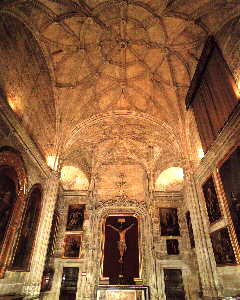 Sacristy of the Chalices
Sacristy of the Chalices |
The Chapel of Los Dolores leads to the Sacristy of the Chalices where a selection of the best paintings owned by the Cathedral are displayed.
The Sacristy has a regular gound plan and its ceiling consists of Gothic rib vaulting.
There are references to it from the beginning of its construction in 1509 when the works were supervised by the architect Alonso Rodríguez.
As from 1512 Juan Gil de Hontañon took part in building it, and after several years of inactivity Diego de Riaño took up the task in 1532 until his death in 1534.
|
From that date until it was finished in 1537 the works were directed by Martín de Gaínza.
At the front of the Sacristy there are two small oratory-chapels, the doors of which flank the exceptional sculpture of Christ known as El Cristo de la Clemencia by Juam Martínez Montañés dating from 1603.
It was made for a chapel of the Charter-house of Las Cuevas de Sevilla, whose patron was the Archdeacon Vázquez de Leca who commissioned the sculpture.
It stayed in its original place until 1836 when it came to the Cathedral as a result of the Secularization.
El Cristo de la Clemencia is one of the most perfect sculptures of the Spahish Baroque because of its bodily beauty and its serene spiritual expression.
|
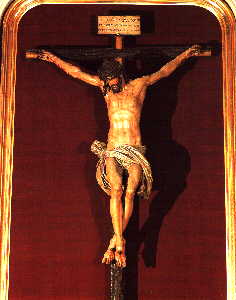 Cristo de la Clemencia by Martinez Montañes
Cristo de la Clemencia by Martinez Montañes
|
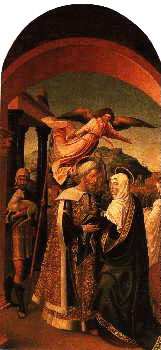 The Embrace of St Joachim and St Ann by Alejo Fernández
The Embrace of St Joachim and St Ann by Alejo Fernández |
In the following this exceptional collection of paintings in the Sacristy is visited from left to right beginning at the entrance door.
First of all there is a panel representing The Virgin with St Peter and St Jerome by Juan Sánchez de Castro.
It dates from the last third of the 15C. Its lower part must have undergone extensive restoration as it has reached our time in a mutilated state.
The left-hand wall of the chapel is occupied by four large panels which were originally attached to the beam that used to be above the main chapel of the Cathedral.
|
They were carried out by Alejo Fernández between 1508 and 1512 and represent The Enbrace of St Joachim and St Ann, The birth of the Virgin, The Epiphany and The Child Jesus is presented in the Temple.
The last section of the left-hand wall has a large panel which, in this case, represents St Peter and may be the on e the painter Pedro Fernández de Guadañupe painted for the Cathedral in 1528.
On the right-han side of the altar of El Cristo de la Clemencia there are another two magnificent panels representing The Calvary by Juan Sanchez de San Román and the Pietá with St Vicent, St Michael and a donor, Signed by Juan Núnez.
Both date from the last third of the 15C.
|
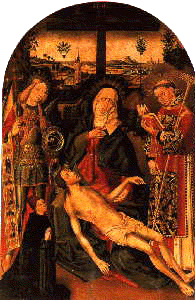 Pietà by Juan Nuñez
Pietà by Juan Nuñez |
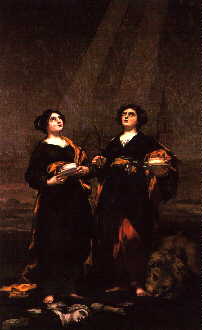 Santas Justa y Rufina by Goya
Santas Justa y Rufina by Goya |
On the left-han side of the altar there is painting ot The Virgin with Child by Zurbarán, and above it a Trinity by Luis Tristán from 1624, which is reminiscent of the style of El Greco who was his teacher.
On the right-hand wall a St Jerome by Pablo Legot from 1640 occupies the first place.
It is clearly influenced by Ribera.
After that there is a Guardian Angel by the italian painter Matía Preti from around 1660, and underneath a representation of St Lazarus with St Mary and Mary Magdalen by Valdes Leal probably from atound 1660.
|
The centre of the right-hand wall is occupied by a magnificent painting representing Las Santas Justa y Rufina.
It is signed by Francisco de Goya and dated 1817.
The painter received the commission for the painting from the Chapter and it was meant to be at the place where El Cristo de la Clemencia is found today, but it was removed from there when the sculpture became part of the Cathedral in 1836.
Goya`s painting is one of his most beatiful as regards religious subjects and it is an exceptional example of his mastery of using his brush and colours.
The physical aspect of the Saints is one of a serene beauty of a popular kind and both figures blend perfectly into open surroundings tinged with blues and greys where the artist has used the River Guadalquivir and the silhouette of the city with the Cathedral and La Giralda as the background.
After this magnificent painting there is a Crucified Christ from the middle of the 17C, which comes from Zurbarán`s workshop, and a representation of The Gloria by Juan de Roelas from around 1615, in which the artist brings out his link with the Venetian shool.
In the next section of the wall we find two excellent paintings signed by the Flemish painter Jacob Jordaens and dating from 1669.
They depict The Epiphany and The Circumcision.
The last painting in the collection of the Sacristy is a St John the Baptist by Zurbarán from around 1640.
| |
|
|






